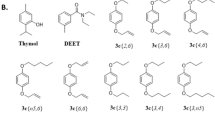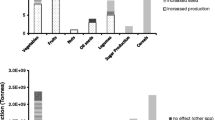Abstract
Varroa destructor is the main concern related to the gradual decline of honeybees. Nowadays, among the various acaricides used in the control of V. destructor, most presents increasing resistance. An interesting alternative could be the identification of existent molecules as new acaricides with no effect on honeybee health. We have previously constructed the first 3D model of AChE for honeybee. By analyzing data concerning amino acid mutations implicated in the resistance associated to pesticides, it appears that pirimicarb should be a good candidate for varroacide. To check this hypothesis, we characterized the AChE gene of V. destructor. In the same way, we proposed a 3D model for the AChE of V. destructor. Starting from the definition of these two 3D models of AChE in honeybee and varroa, a comparison between the gorges of the active site highlighted some major differences and particularly different shapes. Following this result, docking studies have shown that pirimicarb adopts two distinct positions with the strongest intermolecular interactions with VdAChE. This result was confirmed with in vitro and in vivo data for which a clear inhibition of VdAChE by pirimicarb at 10 μM (contrary to HbAChE) and a 100 % mortality of varroa (dose corresponding to the LD50 (contact) for honeybee divided by a factor 100) were observed. These results demonstrate that primicarb could be a new varroacide candidate and reinforce the high relationships between in silico, in vitro, and in vivo data for the design of new selective pesticides.





Similar content being viewed by others
Abbreviations
- HbAChE:
-
Honey bee acetylcholinesterase
- VdAChE:
-
Varroa destructor acetylcholinesterase
- DmAChE:
-
Drosophila melanogaster acetylcholinesterase
References
Abbot SW (1925) A method of computing the effectiveness of an insecticide. J Econ Entomol 18:265–267
Altschul SF, Madden TL, Schaffer AA, Zhang J, Zhang Z, Miller W, Lipman DJ (1997) Gapped BLAST and PSI-BLAST: a new generation of protein database search programs. Nucleic Acids Res 25:3389–3402
Badiou A, Meled M, Belzunces LP (2008) Honeybee Apis mellifera acetylcholinesterase: a biomarker to detect deltamethrin exposure. Ecotoxicol Environ Saf 69:246–253
Benkert P, Tosatto SCE, Schomburg D (2008) QMEAN: a comprehensive scoring function for model quality assessment. Proteins 71:261–277
Briseño-Roa L, Hill J, Notman S, Sellers D, Smith AP, Timperley CM, Wetherell J, Williams NH, Williams GR, Fersht AR, Griffiths AD (2006) Analogues with fluorescent leaving groups for screening and selection of enzymes that efficiently hydrolyze organophosphorus nerve agents. J Med Chem 49:246–255
Chong CR, Sullivan DJ (2007) New uses for old drugs. Nature 448:645–646
Cornman SR, Schatz MC, Johnston SJ, Chen Y-P, Pettis J, Hunt G, Bourgeois L, Elsik C, Anderson D, Grozinger CM, Evans JD (2010) Genomic survey of the ectoparasitic mite Varroa destructor, a major pest of the honey bee Apis mellifera. BMC Genomics 11:602
Corpet F (1988) Multiple sequence alignment with hierarchical clustering. Nucleic Acids Res 16:10881–10890
Cragg GM, Grothaus PG, Newman DJ (2014) New horizons for old drugs and drug leads. J Nat Prod 77(3):703–723
Dainat B, Evans JD, Chen YP, Gauthier L, Neumann P (2012) Dead or alive: deformed wing virus and Varroa destructor reduce the life span of winter honeybees. Appl Environ Microbiol 78:981–987
Dougherty DA (2013) The cation-π interaction. Acc Chem Res 46:885–893
Dulin F, Halm-Lemeille M, Lozano S, Lepailleur A, Sopkova-de Oliveira Santos J, Rault S, Bureau R (2012) Interpretation of honeybees contact toxicity associated to acetylcholinesterase inhibitors. Ecotoxicol Environ Saf 79:13–21
Eisenberg D, Luthy R, Bowie JU (1997) VERIFY3D: assessment of protein models with three-dimensional profiles. Methods Enzymol 277:396–404
Ellman GL, Courtney KD, Andres V, Featherstone RM (1961) A new and rapid colorimetric determination of acetylcholinesterase activity. Biochem Pharmacol 7:88–95
Elzen PJ, Baxter JR, Spivak M, Wilson WT (2000) Control of Varroa jacobsoni Oud. resistant to fluvalinate and amitraz using coumaphos. Apidologie 31:437–441
Eswar N, Eramian D, Webb B, Shen MY, Sali A (2008) Protein structure modeling with MODELLER. Methods Mol Biol 426:145–159
European Food Safety Authority (2005) Conclusion regarding the peer review of the pesticide risk assessment of the active substance: pirimicarb. EFSA Scientific Report 43: 1–76
Evans PD, Gee JD (1980) Action of formamidine pesticides on octopamine receptors. Nature 287:60–62
Gouet P, Robert X, Courcelle E (2003) ESPript/ENDscript: extracting and rendering sequence and 3D information from atomic structures of proteins. Nucleic Acids Res 31:3320–3323
Gracy J, Chiche L, Sallantin J (1993) Improved alignment of weakly homologous protein sequences using structural information. Protein Eng 6:821–829
Harel M, Schalk I, Ehret-Sabatier L, Bouet F, Goeldner M, Hirth C, Axelsen PH, Silman I, Sussman JL (1993) Quaternary ligand binding to aromatic residues in the active-site gorge of acetylcholinesterase. Proc Natl Acad Sci U S A 90:9031–9035
Harel M, Kryger G, Rosenberry TL, Mallender WD, Lewis T, Fletcher RJ, Guss JM, Silman I, Sussman JL (2000) Three-dimensional structures of Drosophila melanogaster acetylcholinesterase and of its complexes with Two potent inhibitors. Protein Sci 9:1063–1072
Hillier NK, Frost EH, Shutler D (2013) Fate of dermally applied miticides fluvalinate and amitraz within honey bee (Hymenoptera: Apidae) bodies. J Econ Entomol 106:558–565
Insecticide Resistance Action Committee (2012) IRAC MoA Classification Scheme
Johnson RM, Dahlgren L, Siegfried BD, Ellis MD (2013) Acaricide, fungicide and drug interactions in honey bees (Apis mellifera). PLoS ONE 8:e54092
Jones G, Willett P, Glen RC (1995) Molecular recognition of receptor sites using a genetic algorithm with a description of desolvation. J Mol Biol 245:43–53
Jones G, Willett P, Glen RC, Leach AR, Taylor R (1997) Development and validation of a genetic algorithm for flexible docking. J Mol Biol 267:727–748
Lambert O, Piroux M, Puyo S, Thorin C, L’hostis M, Wiest L, Buleté A, Delbac F, Pouliquen H (2013) Widespread occurrence of chemical residues in beehive matrices from apiaries located in different landscapes of Western france. PLoS ONE 8:e67007
Loucif-ayad W, Aribi1 N, Smagghe G, NS (2008) Evaluation of secondary effects of some acaricides on apis—disease drug information sharing. African Entomology 18
Maggi MD, Ruffinengo SR, Negri P, Eguaras MJ (2010) Resistance phenomena to amitraz from populations of the ectoparasitic mite Varroa destructor of Argentina. Parasitol Res 107:1189–1192
Maggi MD, Ruffinengo SR, Mendoza Y, Ojeda P, Ramallo G, Floris I, Eguaras MJ (2011) Susceptibility of Varroa destructor (Acari: Varroidae) to synthetic acaricides in Uruguay: Varroa mites’ potential to develop acaricide resistance. Parasitol Res 108:815–821
Milani N (1995) The resistance of Varroa jacobsoni Oud to pyrethroids: a laboratory assay. Apidologie 26:415–429
Mullin CA, Frazier M, Frazier JL, Ashcraft S, Simonds R, vanEngelsdorp D, Pettis JS (2010) High levels of miticides and agrochemicals in north american apiaries: implications for honey bee health. PLoS ONE 5:e9754
Nabeshima T, Kozaki T, Tomita T, Kono Y (2003) An amino acid substitution on the second acetylcholinesterase in the pirimicarb-resistant strains of the peach potato aphid, Myzus persicae. Biochem Biophys Res Commun 307:15–22
Ollis DL, Cheah E, Cygler M, Dijkstra B, Frolow F, Franken SM, Harel M, Remington SJ, Silman I, Schrag J (1992) The alpha/beta hydrolase fold. Protein Eng 5:197–211
Palmer MJ, Moffat C, Saranzewa N, Harvey J, Wright GA, Connolly CN (2013) Cholinergic pesticides cause mushroom body neuronal inactivation in honeybees. Nat Commun 4:1634
Pons JL, Labesse G (2009) @TOME-2: a new pipeline for comparative modeling of protein-ligand complexes. Nucleic Acids Res 37:W485–W491
Potter C (1952) An improved laboratory apparatus for applying direct sprays and surface films, with data on the electrostatic charge on atomized spray fluids. Ann Appl Biol 39:1–28
Rosenkranz P, Aumeier P, Ziegelmann B (2010) Biology and control of Varroa destructor. J Invertebr Pathol 103(Suppl):S96–S119
Ruffinengo S, Eguaras M, Floris I, Faverin C, Bailac P, Ponzi M (2005) LD50 and repellent effects of essential oils from Argentinian wild plant species on Varroa destructor. J Econ Entomol 98:651–655
Scrutton NS, Raine AR (1996) Cation-pi bonding and amino-aromatic interactions in the biomolecular recognition of substituted ammonium ligands. The Biochemical j 319(Pt 1):1–8
Shi J, Blundell TL, Mizuguchi K (2001) FUGUE: sequence-structure homology recognition using environment-specific substitution tables and structure-dependent gap penalties. J Mol Biol 310:243–257
Smodis Skerl MI, Velikonja Bolta S, Basa Cesnik H, Gregorc A (2009) Residues of pesticides in honeybee (Apis mellifera carnica) bee bread and in pollen loads from treated apple orchards. Bull Environ Contam Toxicol 83:374–377
Soding J (2005) Protein homology detection by HMM-HMM comparison. Bioinformatics 21:951–960
Tomlin C (1994) The pesticide manual crop protection publication
U. S. Environmental Protection Agency (EPA), n.d. the ECOTOXicology database. http://www.ipmcenters.org/Ecotox/index.cfm
Vanengelsdorp D, Evans JD, Saegerman C, Mullin C, Haubruge E, Nguyen BK, Frazier M, Frazier J, Cox-Foster D, Chen Y, Underwood R, Tarpy DR, Pettis JS (2009) Colony collapse disorder: a descriptive study. PLoS ONE 4:e6481
Wei Y, Ma Y, Zhao Q, Ren Z, Li Y, Hou T, Peng H (2012) New use for an old drug: inhibiting ABCG2 with sorafenib. Mol Cancer Ther 11:1693–1702
Wiest L, Buleté A, Giroud B, Fratta C, Amic S, Lambert O, Pouliquen H, Arnaudguilhem C (2011) Multi-residue analysis of 80 environmental contaminants in honeys, honeybees and pollens by one extraction procedure followed by liquid and gas chromatography coupled with mass spectrometric detection. J Chromatogr 1218(34):5743–5756
Williamson SM, Wright GA (2013) Exposure to multiple cholinergic pesticides impairs olfactory learning and memory in honeybees. The J of exp biol 216:1799–1807
Williamson SM, Moffat C, Gomersall MAE, Saranzewa N, Connolly CN, Wright GA (2013) Exposure to acetylcholinesterase inhibitors alters the physiology and motor function of honeybees. Front Physiol 5:4–13
Zhou H, Zhou Y (2005) Fold recognition by combining sequence profiles derived from evolution and from depth-dependent structural alignment of fragments. Proteins 58:321–328
Acknowledgments
This work was supported by a fellowship from the Conseil Régional of Basse Normandie (DARM). The authors thank the beekeepers of Abeille Normande du Calvados for their assistance in animal care and for the varroa harvest.
Author information
Authors and Affiliations
Corresponding author
Additional information
Database
Nucleotide sequence data are available in the DDBJ/EMBL/GenBank databases under the accession number(s) KJ499538
Rights and permissions
About this article
Cite this article
Dulin, F., Zatylny-Gaudin, C., Ballandonne, C. et al. Protecting honey bees: identification of a new varroacide by in silico, in vitro, and in vivo studies. Parasitol Res 113, 4601–4610 (2014). https://doi.org/10.1007/s00436-014-4150-z
Received:
Accepted:
Published:
Issue Date:
DOI: https://doi.org/10.1007/s00436-014-4150-z




